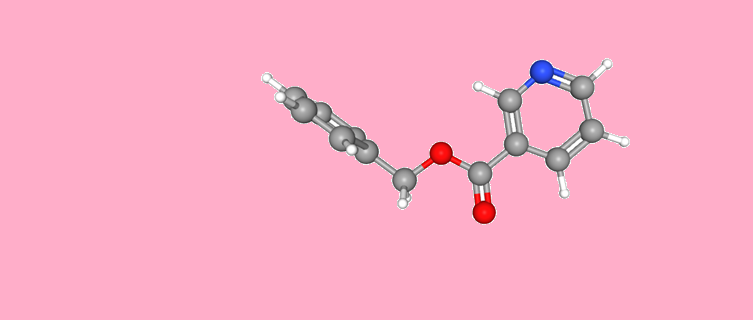INTRODUCTION
Benzyl nicotinate is a benzyl ester resulting from the condensation of the carboxy group of nicotinic acid with benzyl alcohol.
It has a role as a vasodilator agent and is also generally used in cosmetics and drugs. It is an active substance from the group of rubefacients that stimulates blood circulation. Also used in veterinary as well as in human medicines.
| Synonyms | Nicotinic acid benzyl ester Benzyl pyridine-3-carboxylate |
| CAS no. | 94-44-0 |
| EINECS no. | 202-332-3 |
| Molecular formula | C13H11NO2 |
| Molecular weight | 213.23 |
| Structure |  |
Applications
| Used in the treatment of nutritional deficiencies |
| Used to reduce the plasma cholesterol |
| In combination with heparin, used in the treatment of inflammation of vein (thrombophlebitis), pain in dilated veins area, pains and cramps in the leg muscles, disturbances of lymph circulation, traffic and sports related injuries, postoperative and posttraumatic scars, non-joint rheumatism or soft tissue rheumatism |
| Used as skin-conditioning and anti-static agent in creams, baths and emulsions |
| Used for the synthesis of benzyl palladium complexes to be used as catalysts for the substitution of olefins with benzylic groups |
SPECIFICATIONS
| Test | Unit | Specification |
|---|---|---|
| Description | – | Clear, yellowish to brownish yellow or slightly reddish oily liquid with characteristic odor |
| Solubility | – | Miscible with acetone, dichloromethane, ethanol (96%) and in Ether |
| Identification (by IR) | – | Test as per DAB 99 specs should be positive |
| Appearance of solution | – | Test as per DAB 99 specs should comply |
| Acidic substances | – | NMT 1 ml of 0.05 M NaOH solution is consumed |
| Refractive Index | – | 1.569 – 1.570 |
| Halogen Compounds | ppm | NMT 500 |
| Sulphated Ash | % w/w | NMT 0.1 |
| Specific Gravity at 25°C | g/ml | 1.150 – 1.170 |
| Assay (Perchloric acid titration) | % | NLT 98.0 & NMT 101.0 |
| Related Substances (by GC) | ||
| Single impurities | % | NMT 0.5 |
| Total impurities | % | NMT 1.0 |
STORAGE
Store in a cool & dry location and in well-ventilated area.
PACKING
20 kg HDPE Carboy.
Benzyl Nicotinate offered by ExSyn is available on commercial scale. No matter the quantity you need, our exceptional quality and service will make ExSyn your supplier of choice! If you need any additional information or SDS, please get in touch with us.
5-Methyl-3-vinyl-2-oxazolidinone (V-MOX) is a highly reactive monomer valued for its low viscosity, mild odor, and excellent reactivity. It is widely used as a reactive diluent in UV-curable inks and coatings, where it enhances adhesion, produces brighter colors, and improves safety compared to conventional diluents. In addition, V-MOX serves as a key building block in the synthesis of kinetic hydrate inhibitor (KHI) polymers, which are applied in oil and gas production to prevent hydrate blockages in pipelines.
Zinc ricinoleate is the zinc salt of ricinoleic acid, a hydroxylated fatty acid derived mainly from castor oil (Ricinus communis). It appears as a white to slightly yellowish powder, waxy solid, or paste, depending on formulation. Its most valuable property is its ability to trap and absorb odor molecules such as amines, sulfides, and short-chain fatty acids, making it an essential ingredient in deodorant and odor-control products.
2-(tert-Butyl amino)ethyl methacrylate (TBAEMA) is a functional methacrylate monomer that contains a secondary amine group and a hydrophobic tert-butyl moiety, giving it excellent versatility in pH-responsive and adhesion-enhancing polymer systems.
It is valued in printing ink formulations for its ability to enhance adhesion, flexibility, and surface interaction.
Commonly known as potassium bis(fluorosulfonyl)imide (KFSI), the compound has a three-carbon backbone bearing six fluorine atoms and two sulfonimide (-SO₂F) groups. The molecule’s architecture lends it both high chemical stability and useful reactivity. Because of its excellent ionic conductivity and thermal / electrochemical stability, it finds use in advanced electrolyte formulations—for example in lithium-ion and next-generation batteries, in ionic liquids, and in other electrochemical systems.
Colchicine is a naturally occurring alkaloid obtained primarily from the autumn crocus (Colchicum autumnale) and related species. It has been used in medicine for centuries, especially for the treatment of gout and Familial Mediterranean Fever. In modern medicine, Colchicine is valued also in conditions like pericarditis, Behçet’s disease, and certain dermatological and cardiac disorders.
1-Butylimidazole is a versatile organic heterocyclic compound belonging to the imidazole family, where a butyl group (–CH₂–CH₂–CH₂–CH₃) is attached to the nitrogen atom at the 1-position of the imidazole ring. Its applications span organic synthesis, materials science, and bioactive compound development due to its tunable physicochemical properties and structural versatility.
Atropine sulfate monohydrate is a chemical compound, specifically a salt of atropine and sulfuric acid, with one water molecule (monohydrate) attached. It is commonly used as a medication and in research due to its anticholinergic properties, meaning it blocks the effects of acetylcholine at muscarinic receptors.
4-Aminobenzoic acid, commonly abbreviated as PABA, is an aromatic amine and carboxylic acid compound. It consists of a benzene ring substituted with an amino group (–NH₂) in the para position to a carboxylic acid group (–COOH).
2-Amino-5-Nitrophenol (5-NAP) is an organic compound with the molecular formula C₆H₆N₂O₃. It is a substituted phenol with both an amino group (-NH₂) and a nitro group (-NO₂) attached to a benzene ring, along with a hydroxyl group (-OH).
